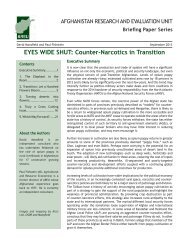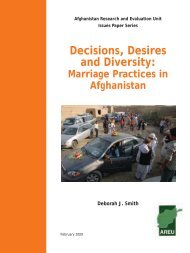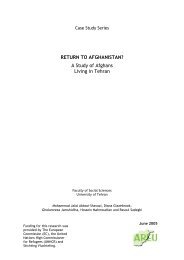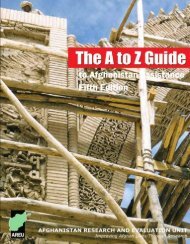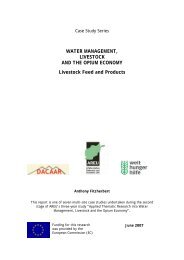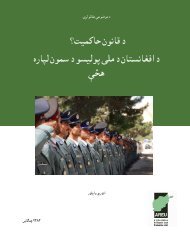Local Governance in Afghanistan: A View from the Ground
Local Governance in Afghanistan: A View from the Ground
Local Governance in Afghanistan: A View from the Ground
- No tags were found...
Create successful ePaper yourself
Turn your PDF publications into a flip-book with our unique Google optimized e-Paper software.
<strong>Afghanistan</strong> Research and Evaluation Unit<br />
2011<br />
districts has not given <strong>the</strong> <strong>in</strong>itiative <strong>the</strong> best chance of success. It seems to have been developed as<br />
a result of donor pressure to achieve sufficient stability to enable withdrawal ra<strong>the</strong>r than to drive<br />
forward a model for <strong>the</strong> development of local government and service delivery.<br />
PRTs: As development actors, PRTs operate under a number of constra<strong>in</strong>ts. The first and most obvious<br />
is that soldiers are not tra<strong>in</strong>ed <strong>in</strong> deliver<strong>in</strong>g development. With <strong>the</strong> military serv<strong>in</strong>g tours of between<br />
six months and one year, <strong>the</strong>re is little opportunity for <strong>the</strong>m to understand <strong>the</strong> complexities of<br />
<strong>the</strong> local culture, despite considerable efforts to help <strong>the</strong>m do so prior to entry and subsequent<br />
support <strong>from</strong> o<strong>the</strong>rs once <strong>in</strong> country. While <strong>the</strong> military were unquestionably s<strong>in</strong>cere and <strong>in</strong>dustrious<br />
<strong>in</strong> apply<strong>in</strong>g <strong>the</strong>ir approach, <strong>the</strong> cultural gulf between foreign military cultures and local norms was<br />
ever-present. The divide was illustrated by <strong>the</strong> way one US Human Terra<strong>in</strong> Team 78 sought to translate<br />
<strong>the</strong> <strong>in</strong>dist<strong>in</strong>ct and flexible structures of Afghan governance <strong>in</strong>to identifiable elements, even us<strong>in</strong>g<br />
biometric measurements to <strong>in</strong>dentify district representatives. 79 Secondly, <strong>the</strong> difficulties of ask<strong>in</strong>g<br />
military to undertake development are made clear by <strong>the</strong> US army manual entitled “Money as a<br />
Weapons System” <strong>in</strong> which aid was def<strong>in</strong>ed as “a nonlethal weapon” used to “w<strong>in</strong> <strong>the</strong> hearts and<br />
m<strong>in</strong>ds of <strong>the</strong> <strong>in</strong>digenous population to facilitate defeat<strong>in</strong>g <strong>the</strong> <strong>in</strong>surgents.” 80 This approach highlights<br />
a fundamental tension between <strong>the</strong> approach used to deliver militarised aid designed for <strong>the</strong> political<br />
purpose of w<strong>in</strong>n<strong>in</strong>g loyalty 81 and approaches that focus on culturally appropriate ways of deliver<strong>in</strong>g<br />
development, alleviat<strong>in</strong>g poverty and reduc<strong>in</strong>g social <strong>in</strong>equality. 82<br />
78 A team of social scientists that is embedded <strong>in</strong> combat brigades and conducts socio-cultural research.<br />
79 Mark Mason, “<strong>Local</strong> District <strong>Governance</strong> Mentor<strong>in</strong>g Models and Case Study” (Jalalabad: Human Terra<strong>in</strong> System, 2009).<br />
80 Commander’s Emergency Response Program, Money As A Weapons System <strong>Afghanistan</strong> (<strong>Afghanistan</strong>: US Forces-<strong>Afghanistan</strong><br />
1 -06), updated February 2011.<br />
81 For a discussion on issues of perverse <strong>in</strong>centives, see: “The Relationship Between Aid, Insurgency & Security: Part One”<br />
(Norfolk, Virg<strong>in</strong>ia: Civil-Military Fusion Centre, May 2011), 7-8; <strong>the</strong> conclusion says “that aid cannot be presumed to improve<br />
security <strong>in</strong> a context of conflict or <strong>in</strong>surgency.”<br />
82 “Quick Impact, Quick Collapse” (Kabul: Oxfam, Afghanaid, Trocaire, Care, NRC, ActionAid, Christian Aid, Concern, 2010).<br />
<strong>Local</strong> <strong>Governance</strong> <strong>in</strong> <strong>Afghanistan</strong>: A <strong>View</strong> <strong>from</strong> <strong>the</strong> <strong>Ground</strong><br />
40



